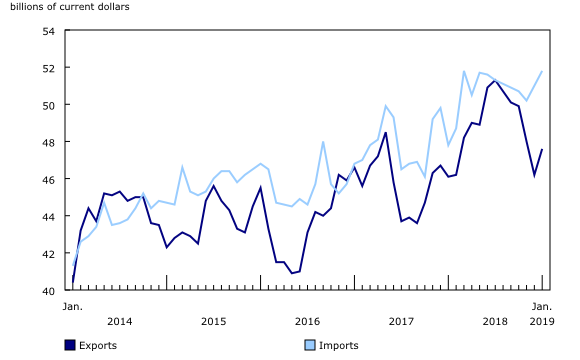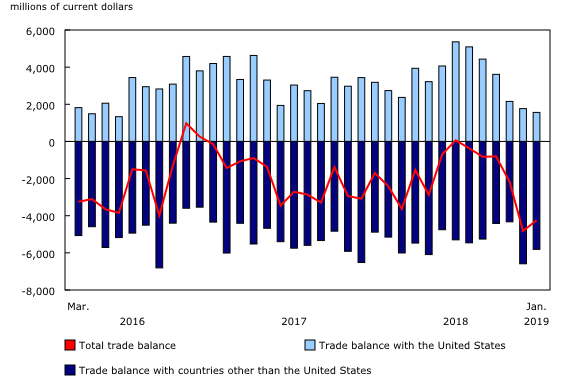Canadian international merchandise trade, January 2019
Archived Content
Information identified as archived is provided for reference, research or recordkeeping purposes. It is not subject to the Government of Canada Web Standards and has not been altered or updated since it was archived. Please "contact us" to request a format other than those available.
Released: 2019-03-27
Canada's exports were up 2.9% in January, mainly on the strength of higher crude oil export prices. Imports rose 1.5%, led by higher aircraft imports. As a result, Canada's merchandise trade deficit with the world narrowed from $4.8 billion in December to $4.2 billion in January.
First increase in exports since July 2018
Total exports rose 2.9% to $47.6 billion in January, the first increase since July 2018. Export prices were up 2.0%, while volumes increased 0.9%. Higher exports of energy products and metal and non-metallic mineral products were partially offset by lower exports of farm, fishing and intermediate food products. Excluding energy products, exports rose 1.2% in January.
After five consecutive monthly decreases, exports of energy products rose 14.0% in January to $7.1 billion. Crude oil exports (+36.5%) drove the gain, on the strength of a 36.0% increase in prices. The price of crude oil exports declined sharply in the second half of 2018, falling by more than 50% from July to December. Despite the increase in January, crude oil export prices were 40.1% below the peak in July.
After decreasing 7.4% in December, metal and non-metallic mineral products rose 11.9% to $5.6 billion in January, the strongest monthly advance since March 2014. The increase was largely due to higher exports of refined gold to the United Kingdom, as well as an increase in gold transfers to Hong Kong within the banking sector in January. For the section as a whole, volumes were up 15.3% while prices fell 2.9%.
Partially offsetting these increases were lower exports of farm, fishing and intermediate food products, down 8.1% to $3.1 billion. Lower exports of other crop products (-25.4%) contributed the most to the decrease, mainly due to lower exports of soybeans to China. This comes on the heels of record exports of Canadian soybeans to China in 2018, a peak that coincided with strong decreases in US exports of soybeans to China.
Aircraft imports six times higher in January
After increasing 1.8% in December, total imports rose 1.5% to a record $51.8 billion in January, essentially on increased volumes. Higher imports of aircraft and other transportation equipment and parts were moderated by lower imports of energy products.
Imports of aircraft and other transportation equipment and parts led the increase in January, rising 52.6% to a record $2.7 billion. After falling to a low of $128 million in December, aircraft imports were up more than six-fold in January. This increase was mainly due to higher imports of airliners from the United States.
The overall increase in January was partially offset by lower imports of energy products, which fell 12.1% to $2.8 billion, mainly on lower imports of refined petroleum products (-16.0%). This follows a 31.1% increase in these imports in December, which coincided with maintenance and turnaround work at some Canadian refineries. For the section as a whole, volumes decreased 10.6%, while prices were down 1.7%.
Higher exports to non-US countries
Exports to countries other than the United States rose 7.9% to $13.6 billion in January, mainly on higher exports to the United Kingdom (gold). Other countries, such as Hong Kong (gold) and Saudi Arabia (other transportation equipment) also contributed to the increase, while China (soybeans) posted the largest decrease.
Imports from countries other than the United States rose 1.1% to $19.4 billion in January, surpassing the record set in December. A number of countries contributed to the increase, including Belgium (pharmaceutical products), the United Kingdom (aircraft and aircraft parts), Saudi Arabia (crude oil), China (various products) and Mexico (various products). These gains were partially offset by lower imports from Brazil (bauxite) and South Korea (iron and steel products).
As a result, Canada's trade deficit with countries other than the United States narrowed from $6.6 billion in December to $5.8 billion in January.
Trade surplus with United States narrows for the sixth straight month
Following five consecutive monthly declines, exports to the United States rose 1.1% to $34.0 billion in January, primarily on the strength of higher exports of crude oil. Imports from the United States were up 1.8% to $32.5 billion, mostly on higher imports of aircraft.
As a result, Canada's trade surplus with the United States narrowed for the sixth consecutive month, from $1.8 billion in December to $1.6 billion in January. Comparing the average exchange rates of December and January, the Canadian dollar gained 0.8 US cents relative to the American dollar.
The share of Canada's exports to the United States was 71.5% in January, compared with an average of 73.9% in 2018. Meanwhile, the share of Canada's imports from the United States settled at 62.6% in January, compared with an average of 64.4% in 2018.
Revisions to December exports and imports
Revisions reflect initial estimates being updated with or replaced by administrative and survey data as they become available, as well as amendments made for late documentation of high-value transactions. Exports in December, originally reported as $46.3 billion in the last release, were revised to $46.2 billion. December imports, originally reported as $50.9 billion in the last release, were revised to $51.0 billion in the current month's release.
New release dates for Canadian international merchandise trade data
Statistics Canada and the United States Census Bureau have identified April 17, 2019, as the new joint release date for the publication of international merchandise trade statistics for the February 2019 reference month. In addition, the release date for the March 2019 reference month has been postponed to May 9.
The publication date for April 2019 reference month remains June 6 as originally planned.
For more information, consult "Impacts of the US government shutdown in the upcoming release of Canadian international merchandise trade data."
Note to readers
Merchandise trade is one component of Canada's international balance of payments (BOP), which also includes trade in services, investment income, current transfers and capital and financial flows.
International trade data by commodity are available on both a BOP and a customs basis. International trade data by country are available on a customs basis for all countries and on a BOP basis for Canada's 27 principal trading partners (PTPs). The list of PTPs is based on their annual share of total merchandise trade—imports and exports—with Canada in 2012. BOP data are derived from customs data by making adjustments for factors such as valuation, coverage, timing and residency. These adjustments are made to conform to the concepts and definitions of the Canadian System of National Accounts.
For a conceptual analysis of BOP versus customs-based data, see "Balance of Payments trade in goods at Statistics Canada: Expanding geographic detail to 27 principal trading partners."
For more information on these and other macroeconomic concepts, see the Methodological Guide: Canadian System of Macroeconomic Accounts (13-607-X) and the User Guide: Canadian System of Macroeconomic Accounts (13-606-G).
Data in this release are on a BOP basis and are seasonally adjusted. Unless otherwise stated, values are expressed in nominal terms, or current dollars. References to prices are based on aggregate Paasche (current-weighted) price indexes (2012=100). Volumes, or constant dollars, are calculated using the Laspeyres formula (2012=100).
For information on seasonal adjustment, see Seasonally adjusted data – Frequently asked questions.
Revisions
In general, merchandise trade data are revised on an ongoing basis for each month of the current year. Current-year revisions are reflected in both the customs and BOP-based data.
The previous year's customs data are revised with the release of the January and February reference months, and then on a quarterly basis. The previous two years of customs-based data are revised annually and revisions are released in February with the December reference month.
The previous year's BOP-based data are revised with the release of the January, February, March and April reference months. To remain consistent with the Canadian System of Macroeconomic Accounts, revisions to BOP-based data for previous years are released annually in December with the October reference month.
Factors influencing revisions include the late receipt of import and export documentation, incorrect information on customs forms, replacement of estimates produced for the energy section with actual figures, changes in classification of merchandise based on more current information, and changes to seasonal adjustment factors.
For information on data revisions for crude oil and natural gas, see "Revisions to trade data for crude oil and natural gas."
Revised data are available in the appropriate tables.
Real-time data table
Real-time table 12-10-0120-01 will be updated on April 8.
Next release
Data on Canadian international merchandise trade for February will be released on April 17.
Products
Customs based data are now available in the Canadian International Merchandise Trade Database (65F0013X).
The updated Canada and the World Statistics Hub (13-609-X) is available online. This product illustrates the nature and extent of Canada's economic and financial relationship with the world using interactive graphs and tables. This product provides easy access to information on trade, investment, employment and travel between Canada and a number of countries, including the United States, the United Kingdom, Mexico, China, Japan, Belgium, Italy, the Netherlands and Spain.
Contact information
For more information, contact us (toll-free 1-800-263-1136; 514-283-8300; STATCAN.infostats-infostats.STATCAN@canada.ca).
To enquire about the concepts, methods or data quality of this release, contact Benoît Carrière (613-415-5305; benoit.carriere@canada.ca), International Accounts and Trade Division.
- Date modified:




